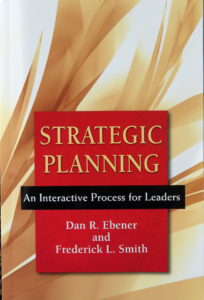Process helps ensure your strategic plan won’t collect dust
By Barb Arland-Fye
“Strategic Planning: An Interactive Process for Leaders” by Dan R. Ebener and Frederick L. Smith, Paulist Press (www.paulistpress.com) $14.95

This is Dan Ebener’s new book “Strategic Planning: An Interactive Process for Leaders.”
Dan Ebener and Fred Smith, colleagues at St. Ambrose University in Davenport, have co-authored a must-read book on strategic planning that would benefit any organization — profit or nonprofit. The Diocese of Davenport is among the more than 100 organizations that have engaged in the process so effectively described in “Strategic Planning: An Interactive Process for Leaders” (Paulist Press).
“The initial thought of doing strategic planning seems daunting. Having been in the process with Dan, I know how much fun it can be and how important it is,” observed Bishop Martin Amos who leads the Davenport Diocese. “We have found the strategic planning steps discovered in this book to be very helpful to our parishes, schools and the Chancery.”
The book isn’t intended as a blueprint, per se, but a step-by-step guide. “I’ve facilitated over 100 organizations’ strategic planning process and no two have been identical,” Dan said.
Strategic planning certainly isn’t a novel concept, but 70 to 80 percent of strategic plans are never implemented. That concerned Dan and Fred, who do consulting work and teach strategic planning at St. Ambrose. Why would businesses and nonprofits expend valuable time in the strategic planning process but not follow through with it? Largely because they get bogged down with the day to day demands of their work, Dan said, and set aside the strategic plan for another day.
Hoping to reverse that outcome, Dan and Fred collaborated on writing a book that would serve as a textbook for their classes at St. Ambrose and as guidebook for businesses and other organizations. The slim, 130-page book describes a doable strategic planning process aimed at creating significant, positive change for organizations.
“Strategic planning is an interactive process where leaders, followers and managers create a common goal together,” Dan and Fred observe in the book’s preface. Their process is simple and that’s why they tried to keep the book simple. They identified eight basic steps to strategic planning: Get the right people at the table; do your homework in advance; focus on your mission and values; prioritize your most strategic areas of concern; generate new and creative ideas to address these issues; take specific steps that can be measured; communicate your new vision clearly; and hold yourself accountable by implementing the strategic plan.
Steps two through seven — from assessing core values to establishing a vision — form the heart of the process, clearly outlined in the book. Dan estimates the process requires two, three-hour sessions spaced about four weeks apart. That gives participants breathing room, without allowing so much time to pass that they barely recall what happened in the first session.
The book incorporates terms and activities that invite participation — conversation cafes, gallery walks and snow cards, the use of different colored markers to track the source of ideas. Participants, if they are physically able, move from table to table to work with different individuals. “It’s a great way to be interactive with people, to get more people involved,” Dan says. He and Fred included experiences of actual businesses and nonprofits in the book, giving it credibility, realism and resulting in a much more interesting read. Professors at two other institutions of higher learning — the University of Notre Dame and Villanova University — plan to use “Strategic Planning” as a textbook in their classes, Dan said.
Admittedly, the hardest part of a strategic plan is writing concrete action steps that hold individuals in the planning process accountable for each action to be completed within a defined timeframe (usually three to six months).
“The action plan is really a key to making implementation more likely,” Dan said. “The Davenport Diocese has been a model of doing strategic planning and holding ourselves accountable,” added Dan, who serves as the diocese’s stewardship director. Blame is taken out of the room by recognizing that some actions won’t get done, need to be adjusted or changed.
“People see strategic planning as something to check off the list,” Dan says. But it’s not. “It’s a real part of organizational life. It’s doing real work. I think of it as creating a sense of urgency about doing the most important work and not just the things that are screaming at us on our email or text messages.”
“It’s reflective work that’s done in a team, in a group … I think we need more reflective time to think about what we are spending time on, what are the most important things we should be focused on?”
(Arland-Fye is editor of The Catholic Messenger.)










